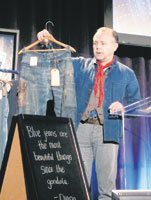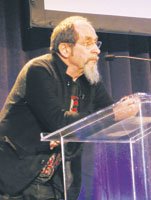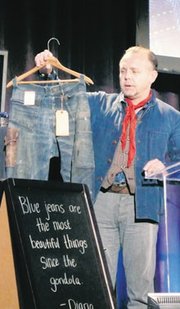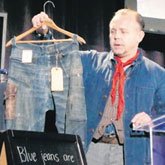Denim Brands Look to Future for Growth, Change
Denim manufacturers are a prime example of Charles Darwin’s rule of evolution. It’s survival of the fittest, and those who don’t adapt die.
That was evidenced at a recent gathering of denim manufacturers and retailers in Los Angeles.
“Denim changes. It is the most changing area of our business that exists. Change is the nature of the denim business,” said retailer Ron Herman, whose namesake stores in Beverly Hills, Brentwood, Malibu and Japan specialize in premium denim. “Be ready for it.”
What that means for denim brands and retailers varies. It could mean pursuing diversification or coming up with environmentally friendly production. It could be maximizing a brand’s identity and history or taking advantage of emerging markets or shifting sourcing and production strategies. Denim companies are approaching growth and planning for the future from every angle.
One point everyone agreed upon at the WWD Denim Forum at the Roosevelt Hotel in Hollywood on May 10 was that denim has proven to be a strong category.In the past 12 months, specialty stores have seen sales of women’s denim grow nearly 15 percent to $3.25 billion. The spike, due in part to a focus on new silhouettes and novelty denim, flies in the face of the rising costs of cotton and labor affecting the entire apparel industry.
Jeff Rudes, founder and chief executive of J Brand, said his brand looks to the high-end-market consumer for inspiration and direction for the future. “She’ll see [fashion], whether it is on a celebrity or on a runway show in Paris, and it happens to be bright colors. [She wants to know] how fast can you get her the bright colors in denim,” he said. “Everything is translating into denim today—whether it’s silhouette, color or shape. There is a lot of fashion that is being turned into denim, and it’s very timely. She always wants it now ... and responding to that is our job.”
For Spring 2012, J Brand will evolve beyond premium denim with the launch of its first-ever sportswear collection. The collection, which will be designed independently of denim but relate back to it in fit and aesthetic, is expected to debut in 100 stores worldwide. “It is an important milestone for us,” Rudes said.Blue goes greenAdriano Goldschmied, partner and executive vice president of product development for Citizens of Humanity and Goldsign, advocated a greener and cleaner denim industry for the future. “It is time to make balance,” he said. “For years, we’ve been thinking about making beautiful product and [about success] hellip; but we’ve never been focused about the responsibility and sustainability of the production process and the responsibility we have to the community. It is only lately that we’ve started to think about what we’re doing.”
Goldschmied said that his generation of denim designers made mistakes, and it is their job to find solutions. “We must give to the new generation a business that is cleaner,” he noted.Recycling denim; mixing cellulosic fibers such as Tencel, Modal, Viscose and Cupro into denim to reduce the amount of cotton used in jeans; and technologies that reduce the amount of chemicals, water and waste used in denim production are all things that Goldschmied thinks will help make the denim industry less harmful to the environment. Citizens of Humanity and Goldsign make 40 percent of their production using machines that use ozone—not water or chemicals—to wash jeans.
Franccedil;ois Girbaud, co-founder of the Maritheacute; + Franccedil;ois Girbaud brand, echoed Goldschmied’s call for curbing the denim industry’s environmental impact.The Paris-based designer, who is credited with inventing the stonewash treatment that gained traction in the ’80s, has been a vocal supporter of new environmentally focused washes, treatments and technologies. Girbaud, who called stonewashing a “huge error,” said he felt particularly responsible for the environment after inventing a wash that took a heavy environmental toll. His company now relies on Wattwash, a laser technique that it developed to age and wash denim using 97.5 percent less water than traditional techniques, to create on-trend and trend-setting denim. (To see a video about Wattwash, click here.)
Christophe Loiron, owner of the Mister Freedom brand of premium denim and a Los Angeles retail store with the same name, floated the idea that, in light of the harmful effects of denim washes, denim brands could eliminate washes altogether and sell raw denim exclusively.Back to the futureRegardless of a company’s strategy, the focus should be evolution and innovation, said Stefano Rosso, head of strategic brand alliances for Diesel SpA and son of Renzo Rosso, founder of Diesel.The company, he said, has a history of reinventing itself as the need and opportunity arises. “We achieve what a lot of people thought was impossible. We were able to take this little line that was a casual jeans line and make it into a lifestyle, iconic premium giant. It was not easy. It took hellip; 30 years, but in the end, we were successful,” Rosso said. Diesel currently owns 15 lines, has 12 licenses and 20 subsidiaries, sells in 5,000 doors, and operates 400 of its own stores.
Rosso said the company is again focusing on the future. “The real challenge is hellip; how do we take it to the next generation? How do we make [the brand] valuable to the next generation?” he said. “Most of the time, brands that have a strong history look at their past and they are just tired of it—and they want to change everything. This is probably the worst mistake. The way to look at the future is to know very well who you are” and build upon that.Diesel, he said, would continue to focus on its special fabrications (which include denim with special weft construction that allows the brand to weave unexpected materials, such as paper and carbon fibers, into its jeans) and innovative washes to grow its denim business. “We invest so much [in innovation] that we make over 800 washes per year—that is more than 2frac12; washes a day that we’ll never be able to put into the market, but it is a way to push the level higher and higher and get better and better every day.”


























